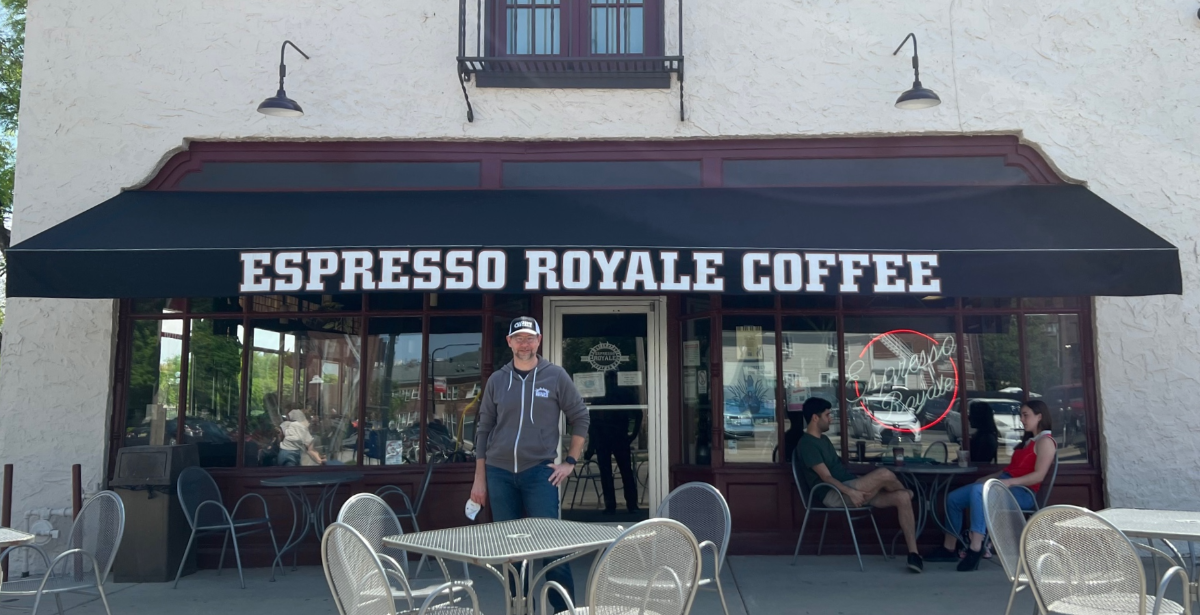Outside the Espresso Royale coffee shop on the corner of Oregon and Goodwin, there is a gray tiled patio with outdoor tables. I walked over to meet the owner of Espresso Royale Coffee Doug McCarver who was sitting in a shaded corner on the patio right by Manolo’s. The coffee shop owner was sipping a cold brew and decked out in Espresso Royale attire: a baseball cap and a zip-up sweatshirt, both clad with the coffee shop’s name.
McCarver wasn’t always the owner of Espresso Royale. He started out as a barista at this very Espresso Royale location in the 1980s. When the pandemic led to the dissolution of Espresso Royale locations, he did everything he could to keep them from closing forever. How did he go from coffee-slinging to owning a coffee shop chain? McCarver opened up about how over the years, he became manager, regional manager, and then owner — and how without Café Kopi, Champaign-Urbana would have lost all our Espresso Royale coffee shops.
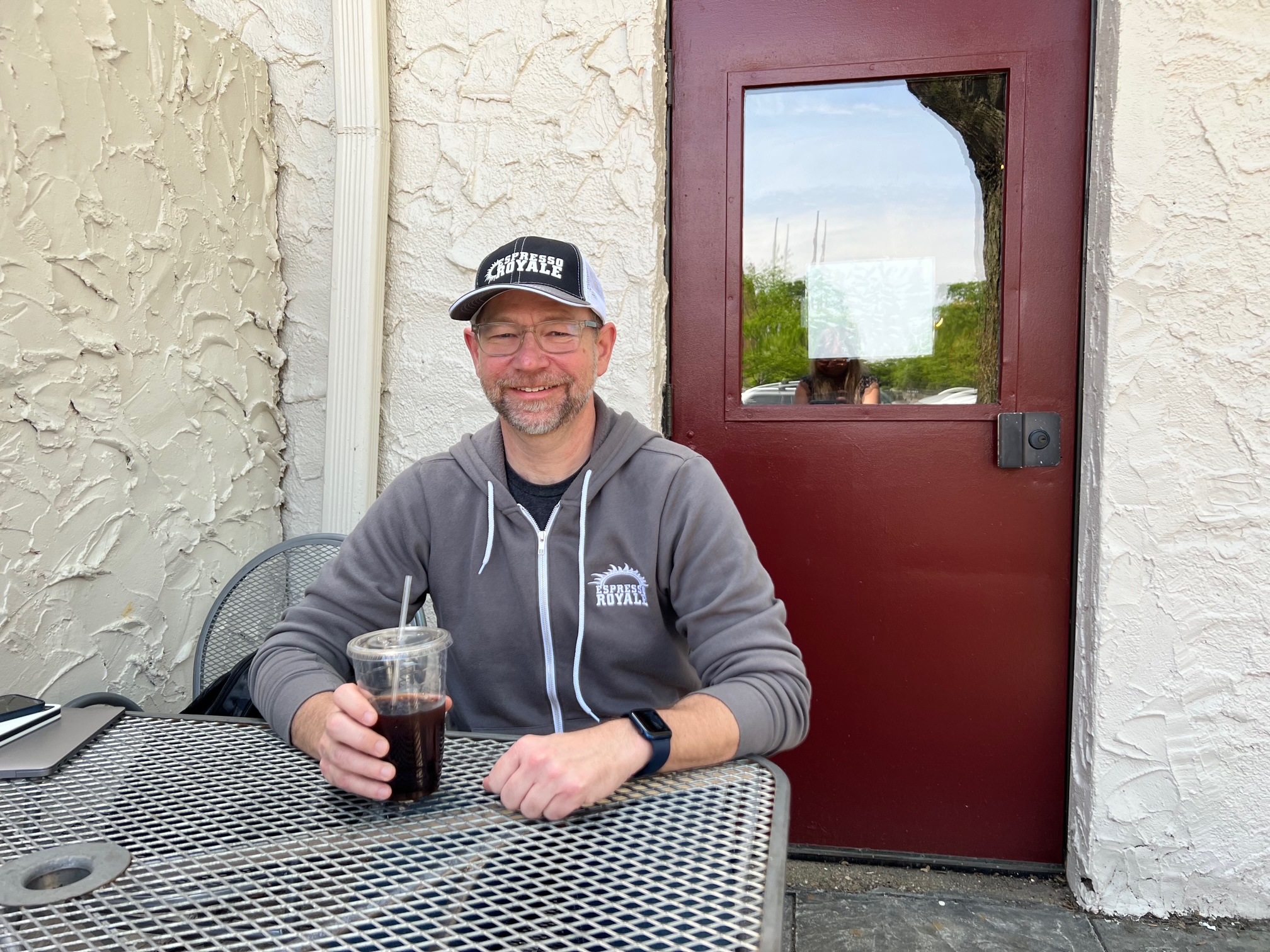
Photo by Alyssa Buckley.
Smile Politely: Let’s start at the beginning. Let’s talk about before the pandemic. Let’s go way back.
McCarver: I started working at this Espresso —
SP: This one? The one we’re at right now?
McCarver: [laughs] Yeah, this one. I started working here in the late 80s. I was a college student, and this opened. It was right at the beginning of the fall semester in 1988. It was an Espresso Royale here, and then over there was a Kinko’s. They were both open 24 hours, and I lived in the dorm right around the corner. We would come here and just hang out. Sometimes at night, sometimes studying, sometimes playing cards or games or talking. I loved hanging out here, so I started working here.
Then when I found out they were opening locations in Madison, Wisconsin, I thought that would be a great place to try to go live and work, so I started my career then in 1990, just becoming a manager. First an assistant, then a manager. Then I came back here in 1992, and I managed the store on Sixth and Daniel. I’ve been working for that company until they went out of business because of the pandemic in early 2020.
SP: So when you returned to Champaign-Urbana after working in Wisconsin, were you coming back to this coffee shop on Oregon and Goodwin after working in Wisconsin?
McCarver: So from there, I went to the Sixth and Daniel location which I managed from August of 1992 until August of 1995. I did come back to this location in the mid-90s, and I managed it for several years. Those were really awesome times. From 1995 to 2000 basically, that had to be the heyday for Espresso Royale in this town. It was such great times, and I loved working here. I loved everyone that I worked with, and [I have] so many great memories of those times. It was always super super busy, too. It was just insane.
SP: So what location opened after this one?
McCarver: The second location they opened in town was the Sixth and Daniel, and it was fun.
SP: So how did you go from managing this one location to managing multiple?
McCarver: Because I was around for so long, I managed the stores and started opening stores for the company. I went to the Krannert Art Museum and opened that store. I opened one in, I think now it’s called the ARC, but it was called the IMPE back then. We had a little location in there for a while, and we had one in the Illini Union Bookstore before Starbucks.
SP: Was it hard to open these locations on campus?
McCarver: No, back then, it was back in the infancy of having stores go into buildings. We had the one in the Illini Union; that was our first University store. Then, the Art Museum had a University-run cafe, but they didn’t want to do it anymore, so they needed someone to take it over. We were really the only option at the time. We took that over, and then we opened these other stores. None of them ever really did that well, so that’s why they all ended up closing. Except for the Art Museum; that one lasted up until the pandemic.
SP: Can you talk about how it went from heydays to the closing of Espresso locations?
McCarver: We were rocking in this town with eight locations. They were all doing fine, and we were in the process of opening another new location, the one that’s in the CIF now. Well, actually, the Sixth and Daniel location one had closed, but that one — the reason that closed was that they basically bought the building to raze it to build. That’s the one I used to run. Things were going well. We’ve always had a great following of local fans.
I mean, this guy Bruce who was just here. He’s been coming here since I first started working here in the 80s. He’s been a regular here, pretty much daily, this whole time.
SP: That’s awesome! In 2020, the eight locations of Espresso Royale were doing well, but then the shops were being closed. Can you talk about that?
McCarver: The shops were owned by a company in Michigan, and you know there was a long history of who actually owned it. Way back in the beginning, Marcus Goller, the founder, initially got money from the Kinko’s guy, the guy who started Kinko’s. So there was a Kinko’s here, Espresso and Kinko’s. The reason we’re here — they said, “We are opening a Kinko’s here, and you should open an Espresso.” So we sort of did that. The Kinko’s company owned the majority of Espresso Royale for a very long time, and at some point, they sold their ownership to some investors in California.
We’ve had stores in California, Boston, Georgia — I mean, that company did.
SP: With the name Espresso Royale?
McCarver: Yeah, they were all over the place. So eventually they sold their ownership to this company in Michigan. It was an investment company, not so much retailers. When the pandemic hit, they decided it was time to cash out and call it quits or whatever.
SP: For all eight locations?
McCarver: The other locations in the other towns.
SP: Wow! So nationwide, Espresso Royale was closing? Dissolving?
McCarver: They really only had locations here, Wisconsin, and Michigan at that time. That company — from the time they took it over until they got out — they started closing stores. If it didn’t meet a certain criteria for them, they just said, “We’ll get rid of it.” It didn’t even matter necessarily if it was profitable; they were just saying, “We’re getting rid of it.” They just didn’t want to deal with it. The people who bought it were investment bankers, and you can imagine that’s not like some coffee company coming in.
SP: So you’re hearing about this as a manager, and are you wondering if your stores will meet the criteria?
McCarver: Well, the stores here were meeting it. We were very profitable. Pretty much all of them. The only one that was problematic was the Art Museum, and that was because the hours were so limited. It was a tough one because people could only come in the daytime, and it was closed on the weekends. It wasn’t losing money, but it really wasn’t making money either.
We were doing really well, and we also had our commissary here. I don’t know. Things were going well before the pandemic, and we’re trying to get back to that. It’s been a slow roll uphill to get back there.

Manager Anika Nims makes a drink on the espresso machine. Photo by Alyssa Buckley.
SP: How did things go from the fund company dissolving these locations to you now owning them?
McCarver: I am the principal owner, managing owner. What happened was — we have to back up a little. I became partners in Café Kopi probably ten years ago or something. I knew the owner Paul West. We had sort of been talking, and I bought into it after talking for a few years.
I thought it was a great little coffee shop, and we had dreams of opening another location. It kept not working out for whatever reason. So I was a partner in Café Kopi — and I was hands off. I let Paul and the manager there run it. Then Paul decided he didn’t want to do it all anymore. At the beginning, there was an agreement that when I got into it, we would be 50/50 partners. When we signed the agreement, he knew (at some point) he wanted to get out. He said to me, “Whenever that was, I’ll let you know, and it will trigger this clause.” I’d pay him X amount of money, and then I’d be the full owner. We had done that maybe a year and a half before the pandemic.
I was the full owner of Café Kopi going into the pandemic, but Paul is still heavily involved. He was doing the books for Café Kopi before the pandemic, and now he does them for all of the stores. The structure that he had set up allowed us to be able to grow from six employees to over 100 now.
SP: Wow, and what was your role with Espresso at that time?
McCarver: Regional manager for all the stores here. So when the pandemic hit, they basically laid off every employee in the entire company and in this town. Except for me. They put me on a third of my salary, and they wanted somebody to check on the stores to make sure the stores weren’t getting ransacked or whatever. It wasn’t a lot of work. I just had to check on the stores like once a week.
This one, actually, we were doing a bathroom remodel. This was my first clue they weren’t going to open back up because all of a sudden, they wanted to get the bathroom fixed. It told me that they wanted to get it fixed because they couldn’t get out of their lease if the bathroom wasn’t fixed, you know? So I was here overseeing that. This was when everything was shut down, and I was meeting the workers all masked and everything. That was like two or three months. Then when they decided that they wanted to get out, they basically just walked away from all of their stores and the University. They made deals with everybody (the landlords and the University) to just walk away and leave all the stuff in exchange for getting out of their leases and the contracts with the University. Then, the landlords of our three Espresso Royales got together and contacted me and wanted to know if I wanted to run them. I was like, “Yeah, I was going to contact you guys because we definitely want to do that.”
They said they wanted to become partners in the company. The landlords of the three Espresso Royales: this one, the one on Neil Street, and the one at The Village at The Crossing. They wanted me to run them, and I told them I owned Café Kopi because they didn’t know that. I told them, “So I have a company right now.”
We had just gotten a PPP loan, and I had been trying to open the [Espresso Royale] drive-through on Neil Street, so we could be serving people through the window. The Michigan company kept saying, “No, no, no. We’re too afraid of liability, you know. If someone gets sick, they could sue us.” So okay, that was fine, but then when they were out of the picture, I told the landlord of the Neil Street location that I really wanted to get this drive-through open as soon as possible because Starbucks still didn’t have theirs open. We needed to come up with a deal, and they came up with a short term lease before we had a deal. So I just used the Café Kopi LLC that I already had, so we didn’t have to start a whole new company. We already had employees; we already had payroll. We already had the infrastructure, so we could start hiring people through the Café Kopi LLC.
I basically started hiring ex-Espresso Royale managers and staff to start running the Neil Street store, and we got it open. There were a few key people that used to be managers that really helped with that. Aaron Bradley was one of them. He was a big help, and he’s still been a big help.
SP: Wow, that’s great.
McCarver: Yeah, so that’s basically how we got it going. That was May of 2020, so two years ago. Then we opened the Village Green one next. We set up the whole online ordering system — which we had already done for Kopi. Kopi was the first one to open back up actually; they were only closed for like three weeks. When we opened that one back up, we scrambled together to get an online ordering system set up for that one, and then we’d already done that once, so when we opened the one at the Village Green location, we did that.
It was so funny. We had this online ordering set up, and we weren’t letting people inside. We had QR codes on the window. I was outside showing people like, “This is how you do a QR code.” They were like, “I don’t understand. I’m supposed to take a picture of it?” And I’d be like, “No, you don’t take a picture. You just scan it.” They’d be like, “Here’s some money. Can you just get me a coffee?” [laughs]
SP: Oh my gosh. Change is hard, but I think (hopefully) now people know how to order from QR codes. That must have been early pandemic. When was that?
McCarver: Summer 2020.
SP: What a time! So the first Espresso that came into Kopi’s fold was the Neil Street location?
McCarver: Yeah. Then, when the new partners let me start serving stuff again, we got up and running.
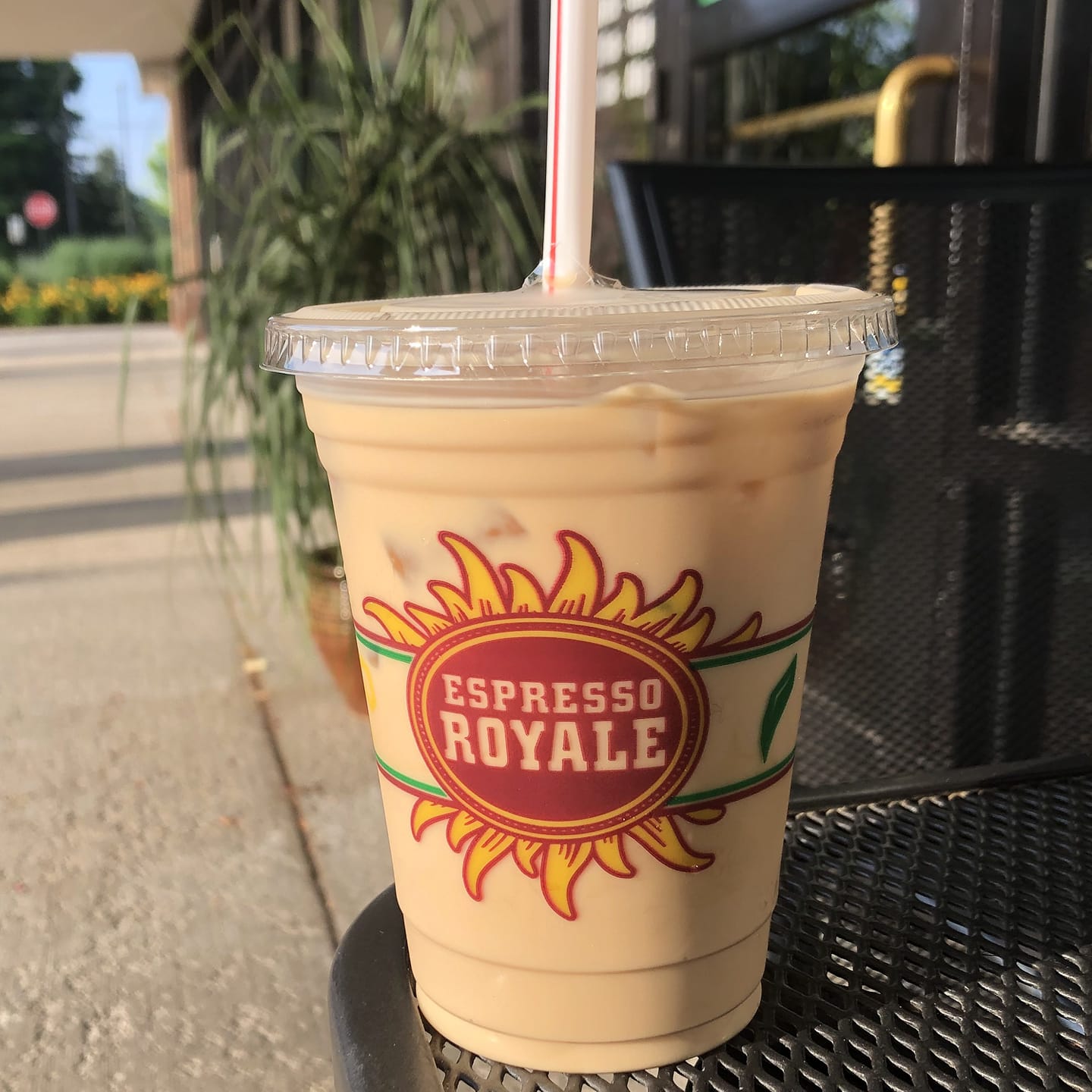
Photo from Espresso Royale’s Facebook page.
SP: You did eventually expand back to campus. That must have been hard with the University being closed for in person classes and the whole building access thing. Can you talk about that?
McCarver: Oh, it was fine. I mean, the first step was to — well, we didn’t have any contracts, so we had to negotiate new contracts for Café Kopi. The biggest challenge this whole time has been for people, especially creditors for Espresso Royale. They’d come and say, “Oh, Espresso Royale owes us this stuff.” We’d be like, “That was the old company. We don’t actually own anything here because they signed over everything to the landlords.” Because the landlords own everything, we’re basically just operating with someone else’s stuff. That’s how it was with the University ones, too. They signed over all of their facilities, equipment, everything to the University, and we came in — and we don’t own any of that equipment. It’s been a little weird that way because when something breaks down, we still have to fix it. And if it costs a lot to fix it, then we should just buy a new one, and then we own it.
SP: It’s nice that you got to inherit a lot, but I can imagine some of the headaches with this.
McCarver: Yeah, so, no, but it was fine. We signed these leases for the existing University locations, but we didn’t — the Undergrad Library and Grainger sat dormant for over a year even after we had a contract. We were always thinking it would open up, but then it didn’t. They didn’t even open the libraries for anyone until finally this last fall in 2021.
SP: Yeah, the University was online for a long time.
McCarver: We did open the one in the Gies College of Business.
SP: Yes, I’ve been to that one!
McCarver: Yeah, that was the first one we opened. Then, we changed that one to a Café Kopi, and so there finally was a second Kopi location.
SP: Okay, so let’s talk about that. I thought it just came in as Café Kopi.
McCarver: It reopened after the closing as Espresso Royale, but then we were supposed to by fall of 2021 convert it to a Café Kopi. So we sort of did that in the summer, last summer. That was slow going, but we got it.
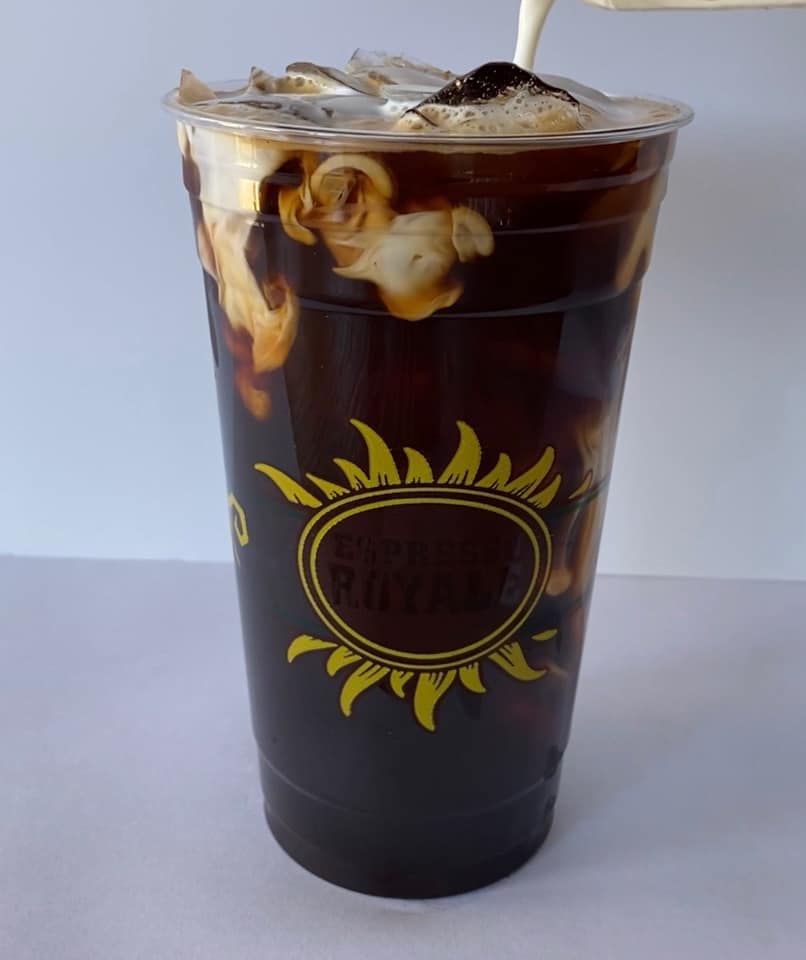
Photo from Espresso Royale’s Facebook page.
SP: Let’s talk about the coffee. What coffee are you using in the coffee shops?
McCarver: We’re using the same coffee we had before the pandemic. Before the pandemic, Espresso had its own roastery in Michigan and roasted its own coffee. The roaster Ken Pargulski was — he’d been around Espresso for a long time. He went to U of I, and he actually used to work at this one.
SP: That is so cool that everyone worked at this very location.
McCarver: So in the 90s, when I managed this store, he was one of my openers at this location. He did it for several years, then he managed stores for a while. Then he went on and learned how to be a master roaster. He took all these classes and stuff somewhere like Colorado, and they opened a roasting facility.
SP: They?
McCarver: Espresso Royale opened a roasting facility in Michigan. Of course, they got rid of that in the pandemic. Ken and Lisa Tuveson (who used to be the Vice President of Espresso) — she’s old school. You have to understand there was the investment firm that came in, bought it, and were sort of the corporate executives. There were the core people who had been there for like thirty years. Lisa had been there longer than me, and she had been in charge of running and opening stores for a very long time even when I was just a manager.
So Ken and Lisa, they bought that roaster, and they kept the roasting going. They decided to re-lease one of the old Espresso Royale locations in Michigan, so it’s called M36 now. It’s not called Espresso Royale anymore. The only Espresso Royales are in this town now.
SP: So Espresso Royale is a totally C-U coffee shop now? There aren’t any more in the rest of the country?
McCarver: Right, so we’re still getting coffee from them — and it’s the same coffee because we really like it. What we’re hoping to do at some point — what we were wanting to do even before now — was bring in roasting from local roasters that are around the area. We want to have them as guest roasters or featured roasters or something. We had one contact with some people in Bloomington, and they have some really good coffee. It’s just been such a crazy time because we still don’t have all the people we need. We have enough people working, but we don’t have enough people in key positions to oversee things like that. At the new location in the Campus Instructional Facility, we’re trying to bring different coffees in to just try them.
SP: How is it managing a local chain with a lot of locations? Can you talk about that?
McCarver: Well, it’s difficult because it’s — I mean, my job role has changed a lot. I used to manage, but I can’t really be the regional manager anymore. It’s just tough because I’m dealing with so many other things, and there’s never enough time to devote to the stuff that needs to be done. So we started an app like an actual app in the App Store. It’s the Espresso Royale Coffee app, and we spent like seven or eight months developing that. We didn’t make it on our own; we used a company called LunchBox. We have that going, but we have a rebuild right now because we’re changing the format. Just keeping up with fresh content. We built a website and keeping up with that is hard. I’d love to have a team of people working on all this stuff, so we always have new content. Like Smile Politely does.
SP: Yeah, we’re always writing new stuff.
McCarver: We need to do that for our website, for the app, for all of our social media. If we did just have one or two locations, it probably would be a lot easier to focus all of that, but when we’ve got multiple locations, there’s so many different things going on — and we have two different brands: the Café Kopi brand and the Espresso Royale brand. Trying to really elevate both of those brands. We want to make sure everything is always a good product.
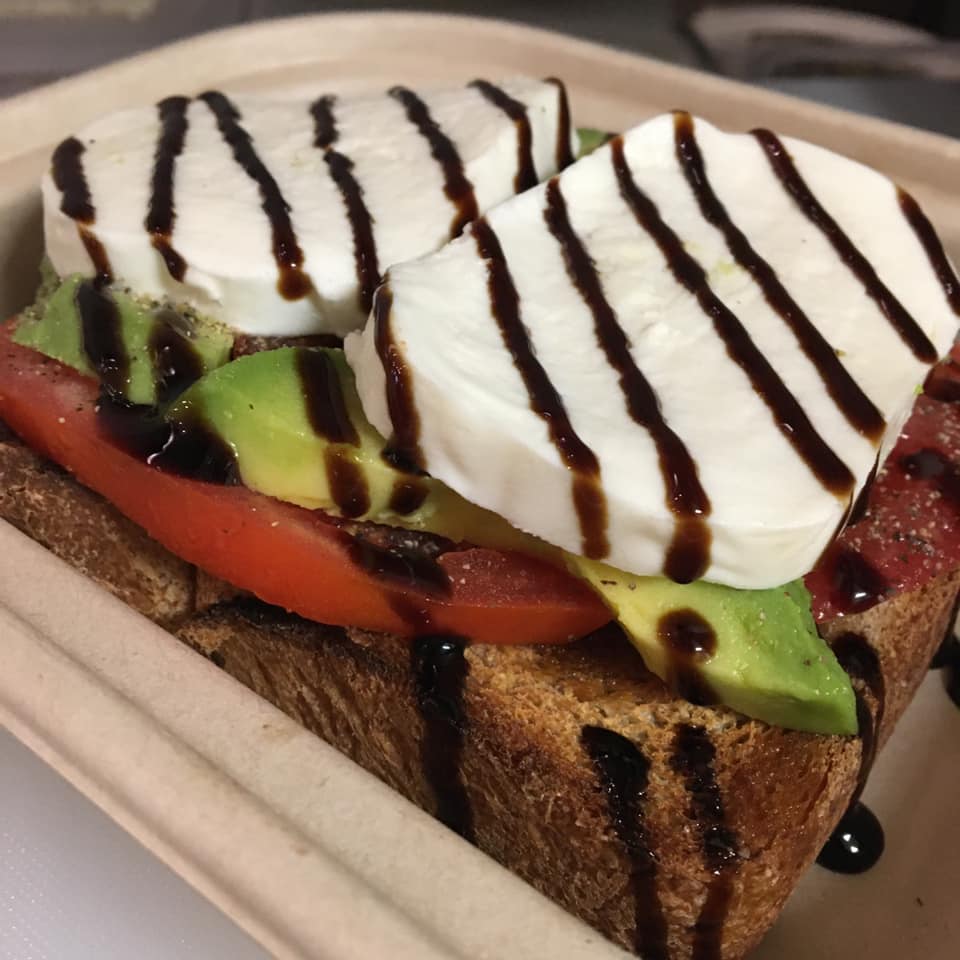
Photo from Espresso Royale’s Facebook page.
SP: Are the menus different for the different brands?
McCarver: Pretty much. What we’ve been trying to do — and it’s taking a lot longer than planned — is to take the really great products from one brand and start using them with the other brand even if they have a different name. So one thing when we opened in the CIF building, we took all the bagels, the bagel sandwiches that were really popular at Kopi, and we started making them there. The main reason we put different names on them was to customize them. So we named them after the different dorm buildings around campus. So there’s a really popular one at Kopi that’s a lox bagel, and when we opened in the CIF, we called it the Lundgren. It has a Swedish or Icelandic sort of name. I don’t know. We just tried to give it a little flair. I thought it’d be fun.
We have two that are called the Shelden and the Leonard. I don’t know if you know this; some people know this, but not everyone knows this. In the Lincoln Avenue residence hall, one’s called Leonard and one’s called Shelden. That’s what those two characters on The Big Bang Theory are named after.
SP: Really?! That’s very cool.
McCarver: Yeah, they’re named after those dorms because the guy that wrote that was from Urbana. I thought that would be funny. Maybe people would go, “Why is that Shelden and Leonard?” and think about The Big Bang Theory, I don’t know.
It always comes up in trivia if you play in town. I’ve heard that a couple of times at trivia nights.
SP: Oh, good to know. I’ve got the answer for my next trivia night now. Thanks for that!
McCarver: [laughs]

Photo by Alyssa Buckley.
SP: Okay, now I’m going to ask you some rapid fire questions. Which coffee shop is the best for meeting up with someone?
McCarver: Oh, well, I picked this one to meet you. This one always has had a special place in my heart because it’s the one where it started. I mean, that was Kinko’s over there, and only this side was the original Espresso. Like I said, I managed it for five years, and it was one of the greatest times, being a cafe manager here.
SP: So where we’re sitting, this is the original C-U Espresso Royale?
McCarver: Yeah. [laughs] I’ve always loved this location. This patio, you know, for most of the time the store has been here, used to be concrete with a big crack in it and two different levels. I don’t know when it was, maybe six or seven years ago, we had the whole thing taken out, and they managed to do it without destroying these walls. Then, put this in, and it’s awesome. It’s so much better than it used to be. [laughs] It was really bad.
One time, we bought this brick-like curing cement, and we mixed it together. We had like ten minutes before it hardened, so we quickly put it in the cracks and painted the whole thing — and it looked great. We didn’t let anybody walk on it for three days or something. That’s what they said to cure. It looked great for like a week or two, but then the pathway between there and that door, just the paint came all off. But it looked good for a little bit.
SP: What if you were going to work remotely, where would you go with a laptop for a quiet space?
McCarver: Well, I like the Downtown Kopi one a lot. I like the Neil Street. They’re all fun. When I was regional manager, I never had an office, so I would go to a different store everyday and work remotely. I’d take my laptop and just hang out. It’s fun, and you can see what’s going on. You see customers, and that was a lot of fun. I did really like doing that.
SP: Where can we get the best coffee to go? Maybe which spot is slinging it out the fastest?
McCarver: Probably the Neil Street location with the drive-through.
SP: What do you hope for the rest of 2022 and for the next few years for your coffee shop group?
McCarver: I hope we can keep growing and stay — that we don’t have to close any stores. It would be great to remodel the stores. We’re building this store at Sixth and Daniel. That’s really great. The plan was: when we closed the other one before they tore it down, we met with the people who were going to put the new building up and talked to them about getting back in there. That was always the plan: to reopen that location. We were there for a very long time and had a lot of good memories.
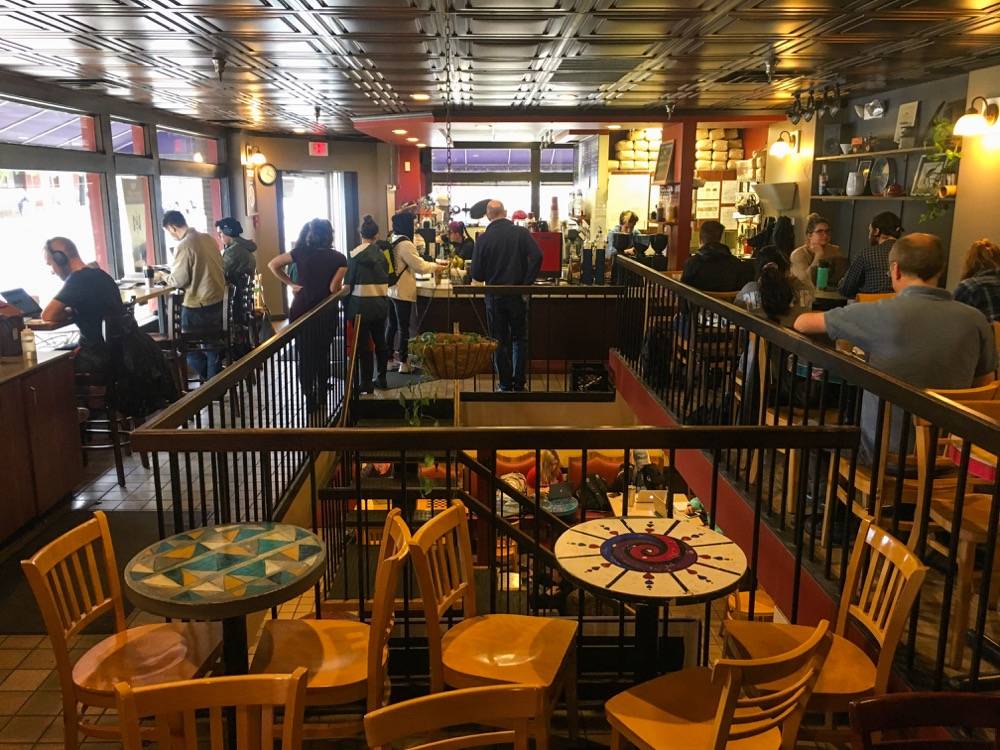
Photo by Steve Pratten.
If you want to see how much that meant to me, Patrick at Smile Politely actually wrote a small article about the situation, and he included my own words about the store closing.
When we closed that for good, we had a little party in there. I still have a plant at home that I took from there that was a plant in the store. And the light! We had a neon light that used to be in there, from the day it opened, and it’s now in the window over here.
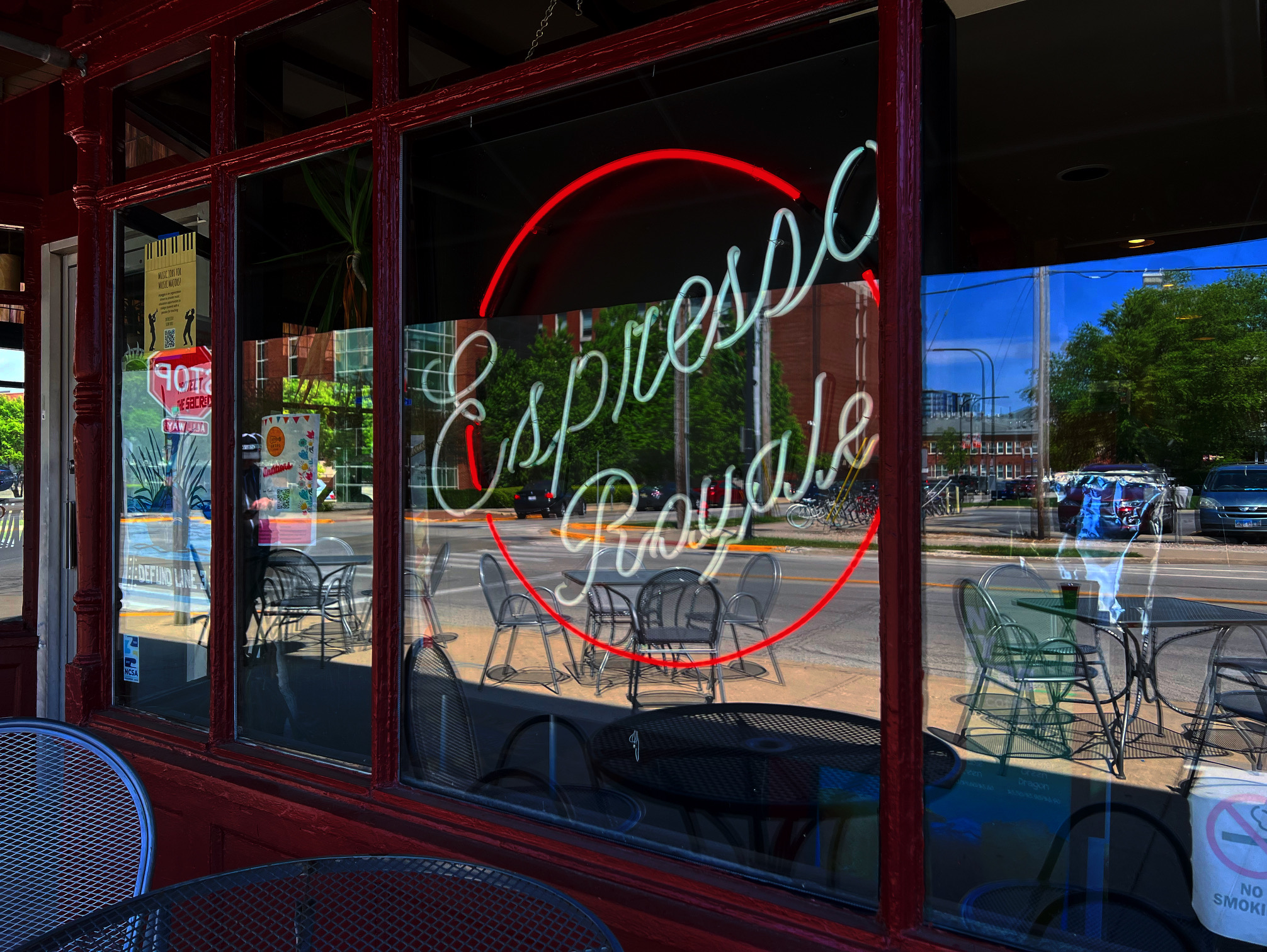
Photo by Alyssa Buckley.
We had to have it refurbished. It was a miracle that we actually got it out of the window and into my car without it just falling apart. We got it into my car, and when we tried to pick it back up, the plastic that it was mounted to was just breaking in our hands. I was like, “How did we even get this here without the whole thing breaking and shattering?” It’s just a bunch of neon tubes on brittle plastic because it was just sitting in this window that was getting sun on it everyday for like twenty years or longer. So that’s a vintage sign that was saved.
SP: And saved by you! You really are saving a lot of Espresso. You’re not some random investor from out of town. You’re someone who worked in these very coffee shops, opened these locations years ago, and now you own them.
McCarver: I have all these hopes and dreams for — you know, at Kopi, we were trying to come up with some new branding for different types of coffee. So we sort of did one, and we called it the Boneyard Blend. No one had really done that as far as I know. It still needs a little bit of work on the branding, but I’d like to get that to be bigger and better than it is.
I think Boneyard is a cool, obviously, a cool thing, and I know there’s the Boneyard Arts Festival every year. It’s weird, but I used to have this cat that was one of my old roommate’s. That cat was rescued from the creek back when it still went through Campustown. There were rocks and stuff in the middle of the creek. They found this cat in the middle of the Boneyard, meowing and really scrawny. It hadn’t eaten in a long time, and so they saved the cat. They named it Boneyard because of that. It was like one of those tuxedo cats. So I used to have this cat named Boneyard, and maybe now I think I should use him as the logo. A scrawny black-and-white tuxedo cat.
SP: That’s a great idea.

Photo by Douglas McCarver.
McCarver: Also, when I got involved with Kopi Downtown, they didn’t have a sign. They just had a banner. It just said Café Kopi, and it was small and half the size of the sign that’s there now, so one of the things I wanted to do was get a permanent sign. So the sign that’s on there now, I spent time working on that on my computer, taking pictures of the store, laying it out, and then we had it made and got it put up. I was super proud of that accomplishment.
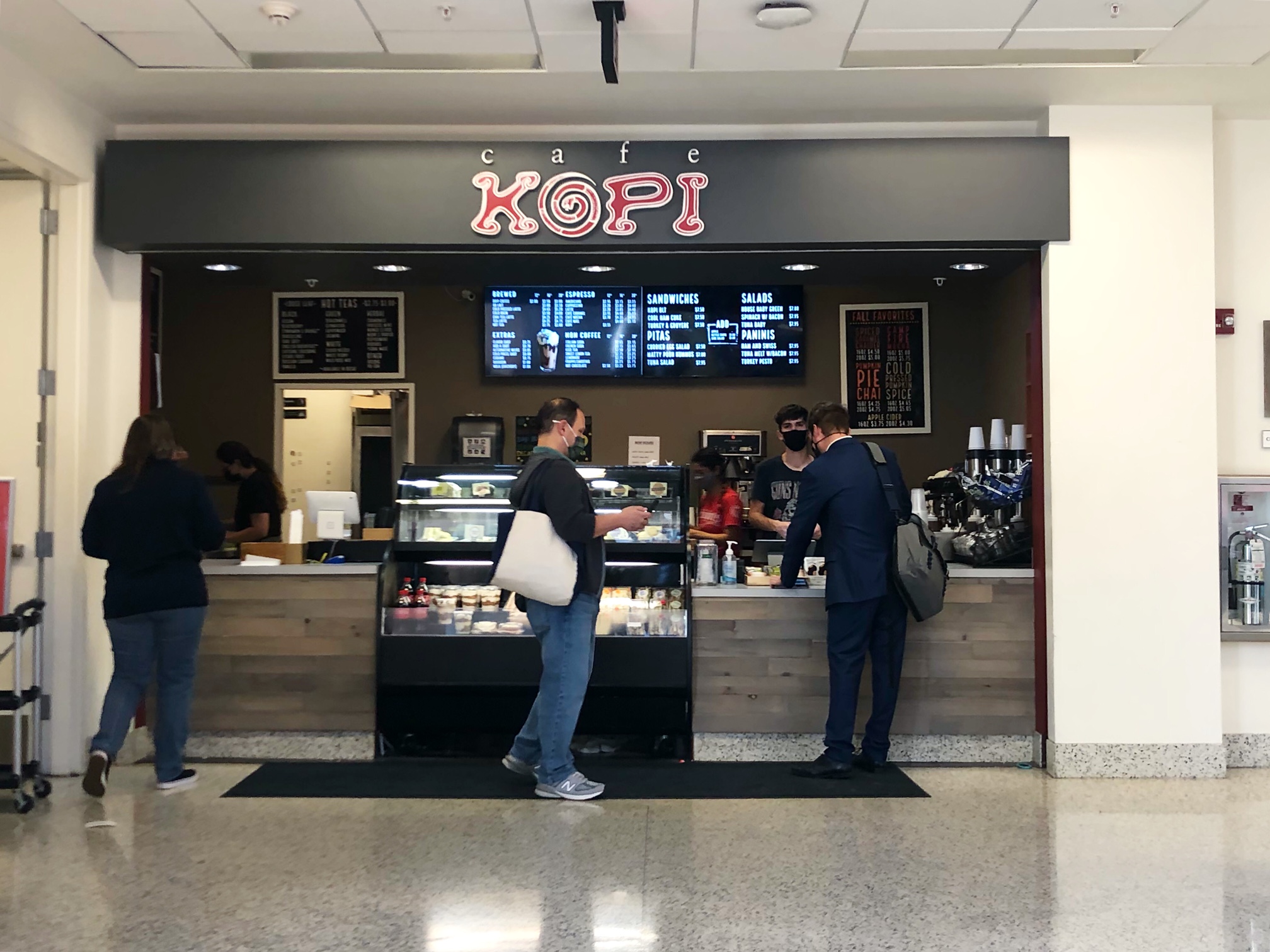
Photo by Alyssa Buckley.
We did a facelift on that one in BIF. It wasn’t a big remodel, but we wanted to change it a little. We painted it and added a new sign. It was fun making those signs, and really, that’s one of the things I’m into.
SP: That’s awesome. I’m curious: what is your go-to coffee order?
McCarver: Well, it was double espresso for a very long time. Lately, I haven’t been drinking that much, so usually, it’s been cold brew, so that’s what I’ve got today.
SP: I love cold brew, too. Do you ever put flavor shots in it?
McCarver: I just drink it black. I don’t put any shots in it because it would be — it’s a different brewing process, so I think it would be weird to put a shot in a cold brew. I know a lot of people do that. I mean, really, the best thing to do with a cold brew is adding just a splash of cream. I don’t do that, but I think the fat from the milk just enhances the flavor of the coffee, even with just a tiny little bit of sweetener.
Some people like coffee really sweet. I don’t ever really put any sweetener or dairy in my coffee, but if I was going to, I would suggest somebody — if they really want to enhance the flavor — it’s like anything else, when you mix flavors together, they can bring out the flavors of the other thing. So when you pair beverages with food, it enhances each of them than when you eat or drink them by themselves. It’s the same thing with coffee. Really, if you add a tiny bit of milk fat or oat milk, add that and a little sweetener, and I think that would really enhance the flavor without overpowering it.
SP: I’m not going to order my cold brew with a shot of caramel anymore. [laughs] Besides coffee, do you have any favorite drinks?
McCarver: Green iced tea. It’s at all the Espresso Royale locations. I’m surprised when I go out to restaurants, and it’s daytime, and I don’t want to have beer or wine or whatever. If they offer iced teas, almost none of the restaurants — that I’ve ever experienced — have green tea. It’s the regular iced tea which is fine, but green tea, again, to me: if you’re eating a nice lunch, a green iced tea just goes really well with it. I love drinking green iced tea.
For nighttime beverages, I like to go to the local brew pubs like Riggs. That’s a great place for this community.
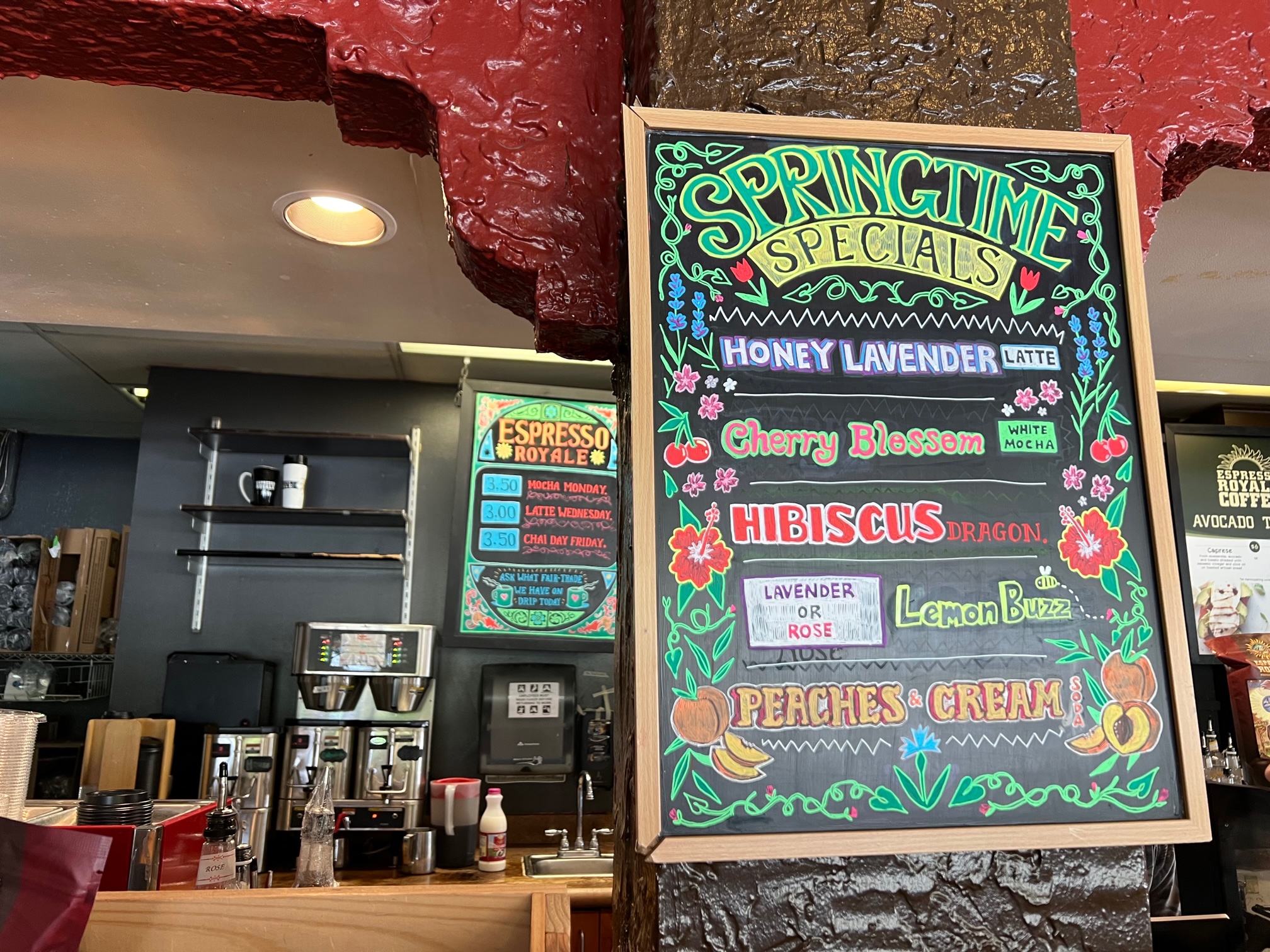
Photo by Alyssa Buckley.
SP: Is there anything else you want to share?
McCarver: I would like to take a moment before we wrap up to thank the people that were instrumental in getting the company where it is.
Gretchen Warner, manager of Downtown Kopi in the beginning of the pandemic, who had to really thread the needle to get the cafe back open three weeks into the pandemic.
Jared Peterson, who took over managing Kopi and who was instrumental in getting the Square online ordering set up for both Kopi locations as well as the Espresso Royale at Village Green — and who later helped with the app.
Aaron Bradley, who reopened all of the locations and got each of them staffed and transitioned from the various stages of pandemic service.
Vicky Dostal, who was at the helm of the Village Green location and who pioneered the online ordering for the Espresso Royale.
Scott Dibler, who got the Bakery and Commissary back up and running.
Victor Cronenberg, who is bringing the company to the next level with the new app and POS integrations and standardizing procedures company-wide.
Paul West, who keeps the company running by single-handedly processing the books, payroll, accounting, and taxes. Everything funnels through him.
Espresso Royale – Krannert View
1117 W Oregon St
Urbana
7 a.m. to 8 p.m., daily
Espresso Royale – Stadium Plaza
Drive-through
1411 S Neil St
Champaign
6:30 a.m. to 8 p.m.
Espresso Royale – Village Green
2401 Village Green Place
Champaign
7 a.m. to 8 p.m.
Espresso Royale – Undergrad Library
1402 W Gregory
Urbana
currently closed
Espresso Royale – Grainger Engineering Library
1301 W Springfield Ave
Urbana
M-F 8 a.m. to 5 p.m.
Espresso Royale – R & D LAB
Campus Instructional Facility
1405 W Springfield Ave
Urbana
closed for summer
Café Kopi Downtown
109 N Walnut St
Champaign
7 a.m. to 8 p.m., daily
Café Kopi in the Gies College of Business
515 E Gregory St
Champaign
M-F 8 a.m. to 4 p.m.








